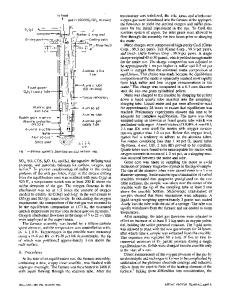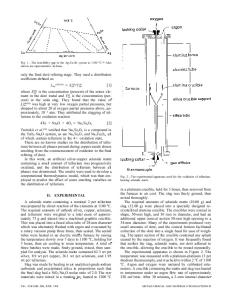Activities of CoS and FeS in copper mattes and the behavior of cobalt in copper smelting
- PDF / 893,100 Bytes
- 10 Pages / 583.28 x 792 pts Page_size
- 13 Downloads / 355 Views
I.
INTRODUCTION
C O B A L T sulfate is sometimes recovered in the course of the electrorefining of copper. ~However, the cobalt contents in actual metallurgical products are seldom reported by copper smelters, while thermodynamic data presently available are short of permitting theoretical estimates for the behavior of cobalt in copper smelting. Thus, the present knowledge on the behavior of cobalt in copper matte smelting is based loosely on a crude analogy with that of nickel. L2.3 Although cobalt is much more valuable than nickel or copper on weight basis, the lack of the relevant thermodynamic data impedes the optimization of its recovery in copper smelting processes. One of the key data required to picture the behavior of cobalt in copper smelting is the activity coefficient of CoS in matte. The value must be established in dilute solution ranges, since the levels of cobalt encountered in copper concentrates rarely exceed a few tenths of one percent. The present work aims at establishing the activity coefficient of CoS in high copper mattes by taking advantage of the distribution equilibria of cobalt between a metallic copper phase and the matte phase. The activity of FeS in the Cu-Fe-S system mattes is perhaps the most important piece of data for analyzing various processes and operations of copper smelting. In recent years, the technology of copper pyrometallurgy has been shifting toward the smelting of higher grade mattes, so that there is an increasing need for more reliable FeS activities in various high grade mattes (60 to 80 wt pct Cu). Since the monumental work on the Cu-Fe-S mattes published by Krivsky and Schuhmann 4 a quarter century ago, however, very little has been reported for thermodynamic properties of high copper mattes. Krivsky et al themselves stated in their paper 4 that their values of FeS activities are in S.N. SINHA is Graduate Student, Department of Metallurgical Engineering, University of Utah, Salt Lake City, Utah 84112. M. NAGAMORI, formerly Associate Professor, Department of Metallurgical Engineering, University of Utah, Salt Lake City, Utah, is now with Centre de Recherches Minrrales, Quebec Govemment, 2700 Einstein, Ste-Foy, Quebec G1P 3W8, Canada. Manuscript submitted November 13, 1981.
error due to the lack then of reliable free energy data for FeS(I). Although the latter data are now well established, no recalculation of their data has appeared in the literature. Furthermore, their activity data are limited to 1623 K, which is some 100 to 150 K higher than the temperatures encountered in most industrial processes of copper smelting. The present work aims at investigating the distribution equilibria of iron between metallic copper and matte so as to establish FeS activities in high grade mattes at temperatures of the actual smelting of copper mattes. The experimental data will also be treated with the use of the free energy data now well established.
II.
EXPERIMENTAL
A. Materials
Copper sulfide Cu2S was prepared by sealing exactly weighed amounts of high purity copper wi
Data Loading...











